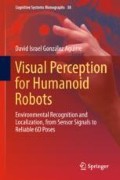Abstract
This chapter introduces a novel uncertainty model supporting visual depth perception for humanoid robots. The supervised learning approach models the visual uncertainty distribution using ground truth data. The validation and discussion of the attained model are presented.
Access this chapter
Tax calculation will be finalised at checkout
Purchases are for personal use only
Notes
- 1.
The depth \(\delta _{Th}\) of a point in the scene produces a disparity smaller than a pixel.
- 2.
Since \(G^v\) is a 3\(\,\times \,\)3 matrix, the the singular values and vector coincide with the Eigenvalues and Eigenvectors.
- 3.
Higher orders \(n \ge 6\) were analyzed resulting insignificant deviations.
References
Alvertos, N. 1988. Resolution Limitations and Error Analysis for Stereo Camera Models. In IEEE Conference Southeastcon, 220–224.
Miura, J., and Y. Shirai. 1993. An Uncertainty Model of Stereo Vision and its Application to Vision-Motion Planning of Robot. In International Joint Conference on Artificial Intelligence, 1618–1623.
Sinz, H., J. QuiÃonero, G. Bakir, C. Rasmussen, and M. Franz. 2004. Learning Depth from Stereo. In on PatternRecognition, ed. D.A.G.M. Symposium, 245–252. Berlin: Springer.
Swapna, P., N. Krouglicof, and R. Gosine. 2009. The Question of Accuracy with Geometric Camera Calibration. In Canadian Conference on Electrical and Computer Engineering, 541–546.
Perrollaz, M., A. Spalanzani, and D. Aubert. 2010. Probabilistic Representation of the Uncertainty of Stereo-vision and Application to Obstacle Detection. In IEEE Intelligent Vehicles Symposium, 313–318.
Di Leo, G., C. Liguori, and A. Paolillo. 2011. Covariance Propagation for the Uncertainty Estimation in Stereo Vision. IEEE Transactions on Instrumentation and Measurement 60 (5): 1664–1673.
Asfour, T., K. Regenstein, P. Azad, J. Schröder, A. Bierbaum, N. Vahrenkamp, and R. Dillmann. 2006. ARMAR-III: An Integrated Humanoid Platform for Sensory-Motor Control. In IEEE RAS International Conference on Humanoid Robots, 169–175.
Hartley, R., and A. Zisserman. 2004. Multiple View Geometry in Computer Vision, 2nd ed. Cambridge: Cambridge University Press. ISBN 0521540518.
Pollefeys, M., L. Van Gool, M. Vergauwen, F. Verbiest, K. Cornelis, J. Tops, and R. Koch. 2004. Visual Modeling with a Hand-Held Camera. International Journal of Computer Vision 59 (3): 207–232.
Noskovicova, L., and R. Ravas. 2010. Subpixel Corner Detection for Camera Calibration, 78–80. International Symposium: In MECHATRONIKA.
Okada, K., M. Kojima, S. Tokutsu, T. Maki, Y. Mori, and M. Inaba. 2007. Multi-cue 3D Object Recognition in Knowledge-based Vision-guided Humanoid Robot System. In IEEE-RSJ International Conference on Intelligent Robots and Systems, 3217–3222.
Azad, P., T. Asfour, and R. Dillmann. 2009. Combining Harris Interest Points and the SIFT Descriptor for Fast Scale-Invariant Object Recognition. In IEEE-RSJ International Conference on Intelligent Robots and Systems, 4275–4280.
Bradley, D., and G. Roth. 2007. Adaptive Thresholding using the Integral Image. Journal of Graphics, GPU, and Game Tools 12 (2): 13–21.
KIT. 2011. Karlsruhe Institute of Technology, Computer Science Faculty, Institute for Anthropomatics. The Integrating Vision Toolkit. http://ivt.sourceforge.net.
Duda, R., P. Hart, and D. Stork. 2001. Pattern Classification, 2nd ed. New York: Wiley. ISBN 978-0471056690.
Scott, D. 1992. Multivariate Density Estimation: Theory, Practice, and Visualization. Wiley Series in Probability and Mathematical Statistics: Applied Probability and Statistics. New York: Wiley.
Vollert, M. 2012. Visual ground truth: Modellierung der wahrnehmungsunsicherheit in einem stereokamerasystem. KIT, Karlsruhe Institute of Technology, Computer Science Faculty, Institute for Anthropomatics: Technical Report.
Bates, D.M., and D.G. Watts. 1988. Nonlinear Regression and Its Applications. New York: Wiley. ISBN 978-0471816430.
Author information
Authors and Affiliations
Corresponding author
Rights and permissions
Copyright information
© 2019 Springer Nature Switzerland AG
About this chapter
Cite this chapter
González Aguirre, D.I. (2019). Visual Uncertainty Model of Depth Estimation. In: Visual Perception for Humanoid Robots. Cognitive Systems Monographs, vol 38. Springer, Cham. https://doi.org/10.1007/978-3-319-97841-3_6
Download citation
DOI: https://doi.org/10.1007/978-3-319-97841-3_6
Published:
Publisher Name: Springer, Cham
Print ISBN: 978-3-319-97839-0
Online ISBN: 978-3-319-97841-3
eBook Packages: Intelligent Technologies and RoboticsIntelligent Technologies and Robotics (R0)

